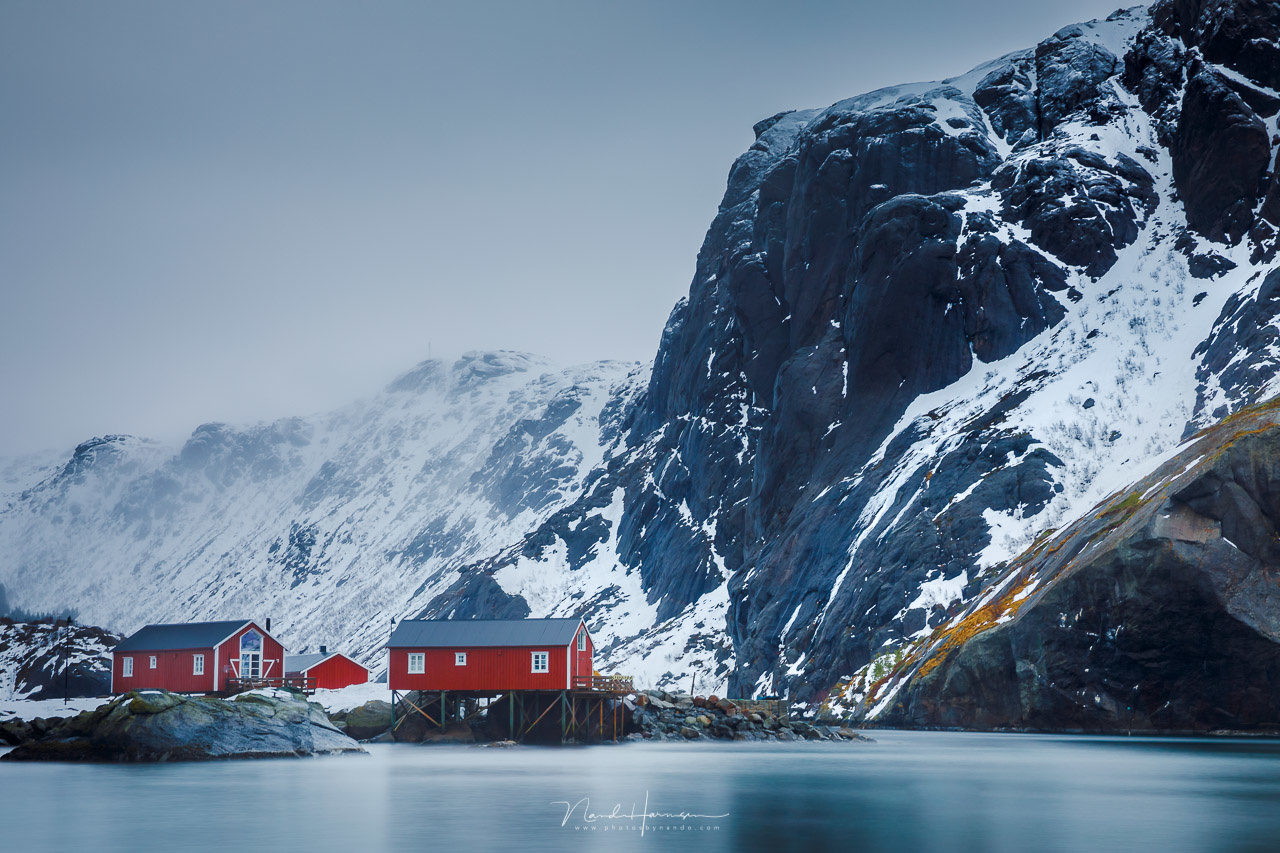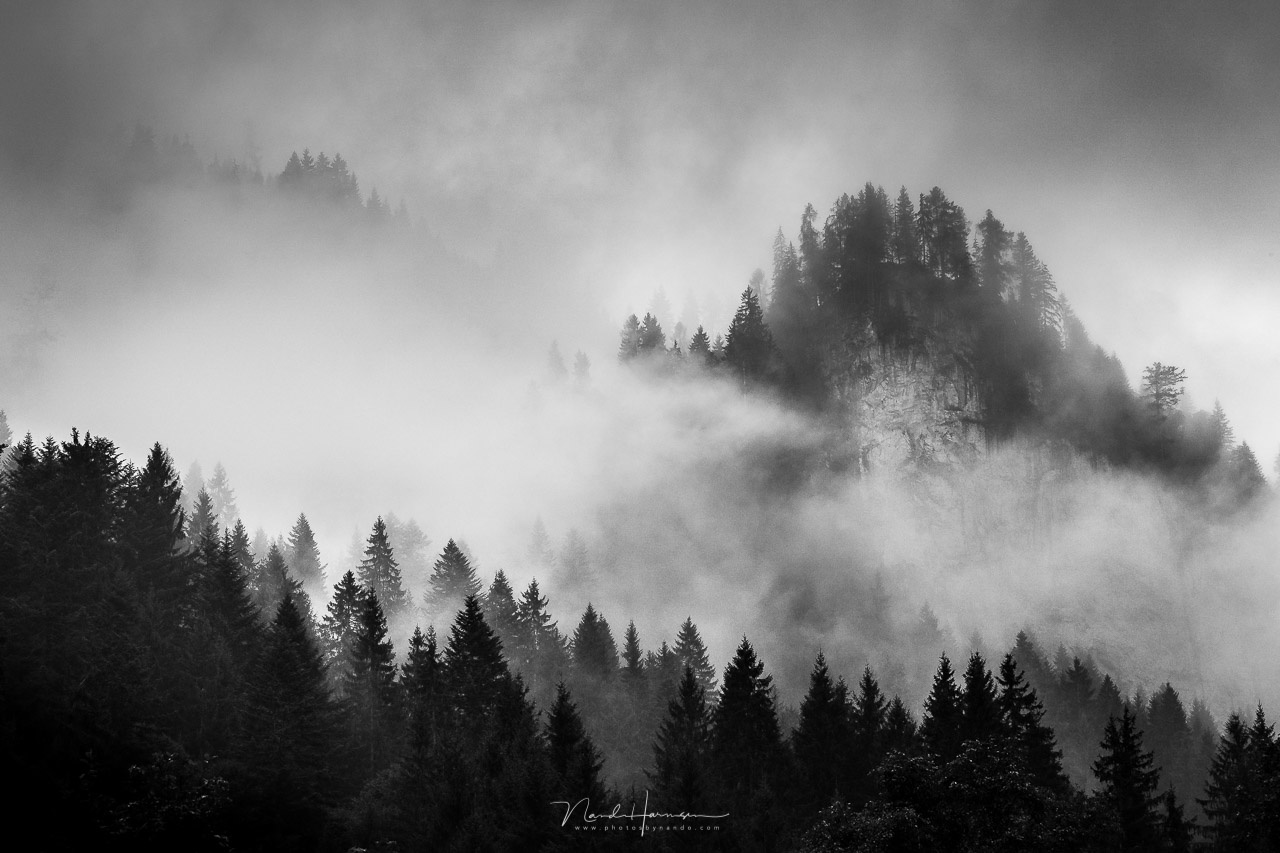It is very easy to take your camera and shoot a landscape. But there is a big chance it will be a disappointing photo. There are six things you should take into account when photographing a landscape. I call it the six pillars for a good landscape photo.
When tips are given for a good landscape photo, it is often about the best exposure, the use of a tripod, the use of filters, or certain camera settings. These tips will make it possible to get your landscape photos technically correct. It will allow you to use a low ISO and a large depth of field. It will eliminate camera shake, or it will allow you to balance the brightness of the light.
But if you have these things in order and everything about your equipment and exposure is correct, the photo won't necessarily be a fantastic one. Photography in general is not only about equipment or exposure. The way you place all elements in the frame is much more important.

Photographing at the Faroe Islands. I use six pillars for my landscape photography, which forces me to look at the landscape in a very different way.
A landscape can be chaotic at times, with an abundance of elements that may be overwhelming. That is why it is so difficult to capture a landscape in a good way. But I believe it may become a bit easier if you take six things into account. I call them the six pillars for a good landscape photo.
1. Find a Clear Subject
A subject in your photo may seem obvious, but it often is forgotten when it comes down to landscape photography. Shooting an amazing landscape will result in a very disappointing photo if there is no clear subject in the frame. There has to be something that attracts attention. If nothing stands out, the viewer has nothing to look at.
So, find yourself a subject and concentrate on that. Take a photo of that subject inside the landscape, and your photo will become much more attractive. There can be only one subject or a couple of elements that together form one subject.

The red houses at Lofoten, called rorbuer, form a very clear subject in this photo. It catches your attention at once, making the landscape much more interesting.
2. Play With Light and Shadow
Light plays a very important role in photography, as does darkness, or perhaps I should say shadow instead of darkness. It is the contrast between light and shadow that will attract attention from the viewer. That is the reason why you should play with both light and shadow to make your photo more interesting.
Our attention is drawn by the lightest part of an image. This is a naturally occurring phenomenon. But perhaps it is the contrast that will make it stand out the most — a light spot in a darker image or a dark spot in a lighter image. It also applies to a silhouette against a light spot in a dark image.
Always keep an eye out for the light in a landscape. Look at the clouds and how the shadows move over the landscape. Look for silhouettes and patches of light in a forest. Keep an eye on how the light changes so you can anticipate when it is time to take the shot.

Photographing this volcanic canyon in France became can be very difficult even with the nice trees that grow between the eroded slopes. When sunlight and clouds are present, you can wait for the light to be at the perfect spot.
If by chance you end up shooting with an overcast sky, you can try to find tonal contrasts in the landscape. It doesn’t have to be extreme, but play with tonal values if light and shadow are not present.
3. Composition Guidelines
One of the most difficult things in photography is composition. We all know about the rule of thirds, regardless of if that is a real composition rule or not. I have written about composition theory and its nine ground forms. You don’t have to use these, but keeping those in the back of your mind can help a lot. I also prefer to name them composition guidelines instead of rules.
It is often a good practice to use the rule of thirds as a basic guideline. But don’t let yourself be forced to use that rule. If the composition is eye-pleasing, it doesn’t matter what it is called. Who knows, perhaps one of the nine basic forms of the composition theory will apply without you knowing it. Just make sure there is a good balance in the image.

I used diagonal lines for this photo in the Austrian Alps; you might even call it the use of the golden triangle.
4. Finding Guiding Lines Through the Photo
I believe it is important to guide the viewer into the photo. This can be achieved by introducing guiding lines. Often, these are related to composition and composition theory. If you place a subject in one of the four centers of attention, according to the rule of thirds, it might be good to guide your viewer towards that subject. It will only strengthen the photo.
Guiding lines can bring a viewer's attention into the center of the photo and even move their attention through the photo itself. With some practice, you can use lines to move the attention in a circle, capturing the viewer inside the photo without any means of escape. This way, people will look much longer at the photo.

Lines can be very powerful in a composition. They guide the viewer through the photo and even towards a certain point in the composition.
5. Point of View and Perspective
It is wise to choose the best height and position for your camera. I see many landscape photographers crawl towards a foreground subject, close to the ground. But that is not always the best choice. Sometimes, it is better to look down on your landscape to open up the lines and patterns in front of you instead of compressing everything in the vertical direction.

By choosing a high viewing point, I got a nice perspective of these geological formation at the Opal Coast. This is unnoticable when you stand on the beach. At the same time, the lines guide you through the photo.
Another good practice is to find a good position relative to the subject. It needs to be in the best possible position against the background. That is why I always move left, right, down, and up to find the most appealing composition. But there is another way of manipulating how your subject and background appear in the photo, which brings me to the last pillar of a good landscape photo.
6. Find a Good Relation Between Foreground and Background
The last pillar for landscape photography is the relationship between foreground and background. It has a strong relation to all the previous pillars, except perhaps light and shadow.
The relation between foreground and background can be manipulated by four different methods. But these are all related to the use of focal length and field of view. The first of these four different methods is the depth of field, followed by the focal length. The third one is the angle of view, and the last one is your distance to the subject.
Choosing these methods with careful consideration makes it possible to get the right relation between foreground and background. It allows you to manipulate the amount of background in the photo, the relative size of the background, and the size of the foreground. Depth of field makes it possible to play with the amount of attention the background receives. Or the foreground, for that part.

I choose a wide angle and a close distance to the foreground to achieve the desired size of the foreground and background. It also has a large depth of field. There are four tools to manipulate the way foreground and background appear in a photo.
I think this last pillar gives a lot of possibilities to build up your landscape photo. That is why I will pay more attention to this relation between foreground and background in an upcoming article.
What Do You Think About These Six Pillars?
Using these six pillars for a good landscape photo won’t be a guarantee for a good photo. But it will help you to make the best possible landscape photo. It forces you to look at the landscape with a different eye, and you might even discover a better way of capturing that wonderful landscape. Or you might even find beauty in a landscape you took for granted for too long.

Don't just take a picture of a landscape. Choose a subject, play with light and shadow, use lines and composition tools, and find the best perspective. Use your focal length, distance, angle of view, and depth of field to make the best possible photo.
How about you? Do you have a special way of discovering the best possible way to capture a landscape? Have you ever thought about these six ways of looking at your landscape photo? Please let me know in the comments below.







I was never able to take a decent landscape photo, I'm going to try these tips
It doesn't guarantee a good photo, but it may help a lot. Good luck :)
When I travel and take some landscape photos. Most of the time, what I see is not always what I get. Point number 1 is somehow crucial but not always as you shown here. Several of your pictures don't have a definitive subject but still looking good.
A subject can be a wide range of things, of course.
Thanks Nando!
I always seem to learn a lot from you, and really appreciate your articles here!
Nice pics as well!
Thanks for your kind words. Appreciate
Lovely simple set of ideas to give you something to think about when presented with a scene. #1 is what I always try and ensure, if the others can also be satisfied then it is a bonus. Thank you Nando